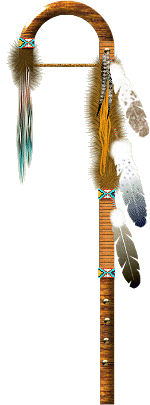
Goyaa³é (Geronimo) was born to the Bedonkohe band of the Apache, near Turkey Creek, a tributary of the Gila River in what is now the state of Arizona, then part of Mexico, but which his family considered Bedonkohe land.
Geronimo's father, Tablishim, and mother, Juana, educated him according to Apache traditions. He married a woman from the Chiricauhua band of Apache; they had 3 children. On March 5 1851, a company of 400 Sonoran soldiers led by Colonel Jose Maria Carrasco attacked Geronimo's camp outside Janos while the men were in town trading. Among those dead were Geronimo's wife, Alope, his children and mother. His chief, Mangas Coloradas, sent him to Cochise's band for help in revenge against the Mexicans
. While Geronimo said he was never a chief, he was a military leader. As a Chiricahua Apache, this meant he was also a spiritual leader. He consistently urged raids and war upon many Mexican and later U.S. groups.
Next he married Chee-hash-kish and had two children, Chappo and Dohn-say, then he took another wife, Nana-tha-thtith with whom he had one child. He later had a wife named Zi-yeh at the same time as another wife, She-gha, one named Shtsha-she and later a wife named Ih-tedda. Some of his wives were captured women he took as a wife, such as the young Ih-tedda. Wives came and went, overlapping each other, being captured and brought into the family, lost, or even given up, as Geronimo did with Ih-tedda when he and his band were captured, at that time he kept his wife She-gha but not the younger wife, Ih-tedda. Geronimo’s last wife was Azul.
While outnumbered, Geronimo fought against both Mexican and United States troops and became famous for his daring exploits and numerous escapes from capture from 1858 to 1886. At the end of his military career, he led a small band of 38 men, women and children. They evaded 5,000 U.S. troops (one fourth of the army at the time) and many units of the Mexican army for a year. His band was one of the last major forces of independent Indian warriors who refused to acknowledge the United States Government in the American West. This came to an end on September 4 1886, when Geronimo surrendered to United States Army General Nelson A. Miles at Skeleton Canyon, Arizona.
Geronimo and other warriors were sent as prisoners to Fort Pickens, Florida, and his family was sent to Fort Marion. They were reunited in May 1887, when they were transferred to Mount Vernon Barracks in Alabama for 5 years. In 1894, they were moved to Fort Sill, Oklahoma. In his old age Geronimo became a celebrity. He appeared at fairs, including the 1904 World's Fair in St. Louis, and sold souvenirs and photographs of himself. However, he was not allowed to return to the land of his birth. He rode in President Theodore Roosevelt's 1905 inaugural parade. He died of pneumonia at Fort Sill in 1909 and was buried at the Apache Indian Prisoner of War Cemetery there.
In 1905, Geronimo agreed to tell his story to S.M. Barrett, Superintendent of Education in Lawton, Oklahoma. Barrett had to appeal to President Roosevelt to gain permission to publish the book. Geronimo came to each interview knowing exactly what he wanted to say. He refused to answer questions or alter his narrative. Barrett did not seem to take many liberties with Geronimo's story as translated by Asa Daklugie. Frederick Turner re-edited this autobiography by removing some of Barrett's footnotes and writing an introduction for the non-Apache readers. Turner notes the book is in the style of an Apache reciting part of their rich oral history.[1]
Religion
Geronimo was raised with the traditional religious views of the Bedonkohe. When questioned about his views on life after death, he wrote in his 1903 autobiography, "As to the future state, the teachings of our tribe were not specific, that is, we had no definite idea of our relations and surroundings in after life. We believed that there is a life after this one, but no one ever told me as to what part of man lived after death...We held that the discharge of one's duty would make his future life more pleasant, but whether that future life was worse than this life or better, we did not know, and no one was able to tell us. We hoped that in the future life family and tribal relations would be resumed. In a way we believed this, but we did not know it."
Later in life Geronimo embraced Christianity, and stated, "Since my life as a prisoner has begun I have heard the teachings of the white man's religion, and in many respects believe it to be better than the religion of my fathers...Believing that in a wise way it is good to go to church, and that associating with Christians would improve my character, I have adopted the Christian religion. I believe that the church has helped me much during the short time I have been a member. I am not ashamed to be a Christian, and I am glad to know that the President of the United States is a Christian, for without the help of the Almighty I do not think he could rightly judge in ruling so many people. I have advised all of my people who are not Christians, to study that religion, because it seems to me the best religion in enabling one to live right."
American Indians
First People is a child friendly site about American Indians and members of the First Nations. 1400+ legends, 400+ agreements and treaties, 10,000+ pictures, free clipart, Pueblo pottery, American Indian jewelry, Native American Flutes and more.